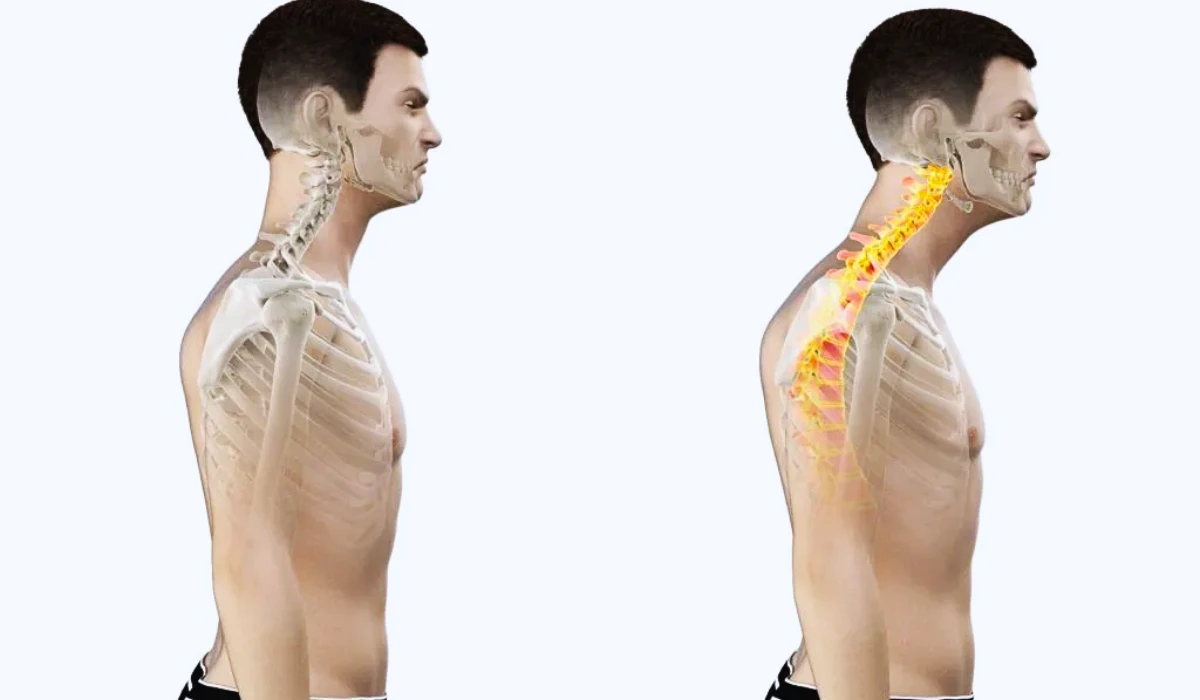Turtle neck syndrome refers to discomfort, pain, or numbness in the neck, shoulders, and arms associated with dysfunction of structures in the neck and shoulder region. Turtle neck syndrome affects people of all ages.
It is a condition that is often overlooked as muscular tightness. When not properly treated, turtle neck syndrome can lead to chronic pain, headaches, poor posture, fatigue, and disturbances in sleep and concentration.
So, this article aims to raise awareness about turtle neck syndrome, its causes, symptoms that may point to the condition, and potential complications if left untreated. We’ll also provide an overview of diagnosis and treatment options for this syndrome. With improved awareness, individuals experiencing neck and shoulder issues can seek immediate medical care. It will help also alleviate the discomfort of individuals further preventing severe, long-term problems.
What are the Causes of Turtle Neck Syndrome?

There are several potential causes of turtle neck syndrome:
1. Nerve compression or irritation
The nerves that travel through the neck can become compressed or irritated by nearby bones, soft tissues, or discs. This can cause radiating pain in the shoulders and arms.
2. Muscle strain
Overuse, repetitive motions, or poor posture can lead to muscle tightness or spasms in the neck and shoulder. These strained muscles can place pressure on nearby nerves.
3. Changes to neck vertebrae
Conditions like arthritis or injuries can cause vertebrae in the neck to shift position or develop bone spurs. This places pressure on nerves, blood vessels, and soft tissues.
4. Injuries
Past injuries such as falls where the head/neck is sharply forced forward and backward can damage soft tissues and misalign vertebrae. This will cause nerve and tissue dysfunction over time.
5. Degenerative disc disease
Deterioration of the discs between neck vertebrae can cause nerve compression and inflammation as disc material contacts nearby nerves.
Identifying potential causes is important because that informs the proper course of treatment. An accurate diagnosis requires input from a doctor, who will evaluate symptoms, and medical history and conduct tests if needed.
Symptoms of Turtle Neck Syndrome?
Some of the common symptoms of turtle neck syndrome are:
- Neck stiffness, tightness, or pain with movement
- Shoulder and arm pain, numbness, or tingling
- Headaches originating at the base of the skull
- Reduced range of motion when turning or flexing the neck
- Muscle spasms or soreness in the neck and shoulders
- Pain or numbness radiating from the neck toward shoulders/arms
- Dizziness
- General fatigue potentially stemming from poor sleep due to pain
Symptoms affecting the arms and hands, like numbness, tingling, or pain can also be because of the compressed or irritated nerves in the neck region.
Complications of Severe Turtle Neck Syndrome
When neck and shoulder discomfort is overlooked or self-treated with home remedies without lasting relief, there may be an underlying issue that needs medical care. Without proper treatment, turtle neck syndrome could worsen over time or cause additional health problems. These are the potential issues if turtle neck syndrome becomes severe.
Nerve damage
Unresolved nerve compression can lead to nerve damage and disrupted nerve signaling from the neck into the shoulders, arms, and hands. This nerve damage can become permanent if prolonged.
Functional impairments
If nerve signaling from the neck is diminished, it can make everyday activities requiring shoulder/arm mobility more difficult and painful. Things like lifting objects, getting dressed and self-grooming could require modifications.
Chronic headaches
Headaches originating in the neck often start temporary but may increase in frequency and severity if not treated. This frequently interferes with work performance, concentration, and quality of life.
Disc herniation
Untreated issues with neck discs could lead to further disc deterioration, with disc material protruding outward (herniation). This will worsen nerve compression and inflammation.
How Is Turtle Neck Syndrome Diagnosed?
To diagnose the underlying cause of turtle neck syndrome, a physician, physical therapist, or chiropractor will:
- Ask about medical history and onset of symptoms
- Conduct range of motion tests
- Feel for areas of muscle spasm
- Test muscle strength
- Check nerve functioning like sensation and reflexes
- Order imaging like X-ray, MRI, or CT scans to visualize neck vertebrae and tissues
Customized treatment will then be ordered based on exam findings and diagnosed causes.
How to Get Your Turtle Neck Syndrome Treated?
Common treatments for turtle neck syndrome include:
Medications
Anti-inflammatory drugs (NSAIDs), muscle relaxers, or pain relievers may relieve symptoms, particularly during initial recovery.
Physical therapy
Gentle stretching, soft tissue mobilization, therapeutic exercises, posture training, and joint mobilization can help reduce pain while improving flexibility and muscle function. This also helps strengthen neck and shoulder muscles to better support vertebrae.
Chiropractic care
Spinal manipulation or neck adjustments can realign vertebrae to decrease nerve compression. Soft tissue therapies may also be applied.
Nerve block injections
Cortisone injected around irritated nerves can quickly reduce nerve inflammation and radiating pain into the shoulders and arms.
Surgery
If conservative treatments fail and imaging shows contributory bone spurs or severe nerve compression, surgery may be necessary to decompress affected nerves.
Across these treatment options, the ultimate goals include alleviating nerve irritation, restoring strength and mobility to the neck and shoulders, improving posture/alignment, and providing lasting relief. With a customized treatment plan, most cases of turtle neck syndrome greatly improve or fully resolve.
Conclusion
Turtle neck syndrome refers to common but underappreciated neck and shoulder problems. They are often caused due to compressed, inflamed, or damaged nerves in the neck region.
Contributing factors range from muscle strain to vertebrae changes to past neck injuries. Resulting symptoms include soreness concentrated in the neck and shoulders as well as radiating pain, numbness, or headaches.
In most cases, symptoms significantly resolve with the right treatment approach. However, alleviating this neck and shoulder dysfunction requires acknowledging subtle symptoms. Don’t dismiss them as temporary muscle tightness.
Pay attention to neck discomfort affecting sleep, headaches originating from the neck, or radiating pain into the shoulders and arms. Don’t ignore symptoms assuming they’ll resolve. Be proactive about your neck health get evaluated and seek care if the problem persists.
Living with chronic neck pain or worsening nerve symptoms is unnecessary when expert treatment can effectively target the source.
Will you discuss any nagging neck tightness or discomfort with your doctor at your next visit? Catching and addressing problems early is key to preventing chronic issues down the road.

